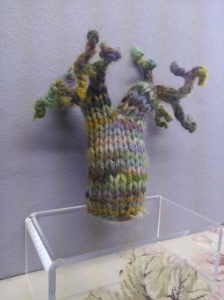These little trees are knitted in the round and repeatedly divided in two to form branches and twigs. They could also be crocheted but I haven’t tried it yet so I’ll talk in terms of knitting. Once I get time to try it I’ll write it up. In the meantime have a go yourself once you get the idea of the knitting.
The choice of yarn and needles is up to you. Browns and greens are best for colour. Thickness of wool and size of needles can vary but it’s best to work to a slightly tighter tension so the stuffing doesn’t show through. I’ve used a set of five double pointed needles in my test pieces but you could use circular needles and the magic loop technique. Spare dpns are handy as stitch holders towards the end and when you’re making i-cord branches.
In order to be successful with all these divisions you need to start with a power of two stitches. Not just a multiple of two – every time you divide your stitches in two each part must also be divisible by two. So you need numbers like 4 (2×2) or 8 (2x2x2) or 16 (2x2x2x2) or 32 (2x2x2x2x2) and so on. The first couple of these will give you a very small structures without much branching so I’d recommend starting with 16, 32 or 64 stitches, depending on the yarn and needles chosen.
Once you’ve decided how many to start with cast them on, join in a circle, place a marker at the start of the round and knit the trunk of your tree. Trees come in many shapes and sizes so you can make it short and squat or longer and thin. For your first tree I’d knit as many rounds as you have stitches cast on.
Now place half the stitches on a holder and knit rounds with the rest. Your first branch is under way. As many rounds as you have stitches and then split again. Keep doing this until you run out of stitches. Cast off and break the yarn.
Rejoin the yarn at the smallest split pick up the stitches and work to the end. Then go back and to the next smallest split and work to the end splitting as you go. Eventually you’ll work back to the first split in the trunk and so you pick up the stitches and work the same branching structure at this side of the trunk. Once you’ve run out of stitches to pick up and all the branches have tapered off then stuff the tree with toy stuffing. Gently push the stuffing into the branches and the floppy tree skin you knitted should start to support itself.
When you are a happy that the tree is well stuffed stitch a piece of felt across the bottom of the trunk or pick up stitches round the hem and knit a base – if you want you could even knit a few big roots to make it more realistic.
If you’d like to contribute your tree to the Botanica Mathematica specimen collection please send it, with a note of your name and location (and anything else about it you think we’d find interesting), to:
Madeleine Shepherd
Coburg House Art Studios
15 Coburg Street
Edinburgh
EH6 6ET
United Kingdom
Simple Binary Bonsai Pattern
- Cast on 16 stitches, join in a circle, place marker.
- Knit 16 rounds.
- Place 8 stitches on holder.
- Knit 8 rounds on remaining 8 stitches.
- Place 4 stitches on another holder.
- Knit 4 rounds on remaining 4 stitches.
- Place 2 stitches on another holder.
- Knit 2 rounds on remaining 2 stitches.
- Cast off and cut yarn.
- Pick up 2 stitches from line 7, rejoin yarn and work lines 8 and 9.
- Pick up 4 stitches from line 5, rejoin yarn and work lines 6 to 10.
- Pick up 8 stitches from line 3, rejoin yarn and work lines 4 to 11.
- Tuck all the ends of yarn inside the tree. if there are any odd gaps stitch them closed with some spare yarn.
- Stuff tree with toy stuffing.
- Close the base of the trunk with knitting or by stitching a circle of felt in place.


April 6, 2013 at 5:04 pm
Thanks for finally writing about >Binary Bonsai | Botanica Mathematica <Liked it!
Pingback: Holiday in the Highlands | Knot your average sheep...
Pingback: Edinburgh Events Annouced! | Botanica Mathematica
Pingback: Binary Bonsai Workshop on 15 March | Botanica Mathematica
Pingback: Fibonacci Tree | Botanica Mathematica
April 23, 2014 at 1:30 pm
When i saw this linked from another site i thought “who could mathematically shape a Bonsai” haha great post and a great site, i had no idea anything like this existed so am just jumping down the rabbit hole on your site now 🙂 Time to pick up the old needles and see what i can do. Thank you!
April 23, 2014 at 1:51 pm
Have fun, Mark and let us see what you make! The Fibonacci tree in the 1st April post is even more realistic so check that out too.
Pingback: Final Call for Trees! | Botanica Mathematica
Pingback: Binary Trees – The Raksura Colony Tree